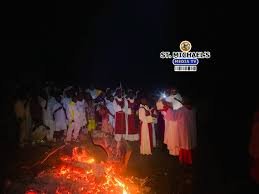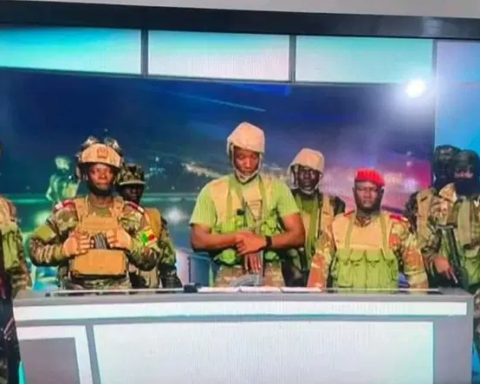There’s a group of men in the Church, devout, organized, and deeply committed, but in many parts of Nigeria, when these men appear in white garments with capes, gloves, swords, and badges, especially during big Masses or funerals, people begin to murmur.
Some look at them with wonder. Others with suspicion.
You hear whispers:
“Is this a Catholic thing?”
“Why are they using swords?”
“Is this not cultism?”
For many, especially those who have never been properly taught, the sight of Catholic Knights stirs fear and confusion.
And yet, these men, the Knights of the Church, are not a secret society. They are a sacred society. Their mission is not hidden in darkness, but shining in the light of Christ and the teachings of the Church.
THE ORIGIN OF CATHOLIC KNIGHTHOOD
Catholic Knighthood is not a Nigerian invention. It traces its roots back to the early centuries of the Church, when Christian men, especially in Europe, took vows to defend the faith, protect pilgrims, care for the sick, and serve the poor.
In those days, the Church was surrounded by war, political tension, and persecution. So, the Knights Templar, the Hospitallers, and other orders were formed to combine Christian devotion with brave service. These were men of prayer, and men of action.
Today, this spirit lives on, not in carrying weapons to fight enemies, but in using every strength to serve the Church, defend the truth, and promote justice.
In Nigeria, we know them as:
The Knights of St. Mulumba
The Knights of St. John International
The Knights of Columbus
These knights are not outsiders. They are Catholics like you and me. Some are doctors, others are farmers, teachers, civil servants, traders, students, even priests and bishops. They live among us, serve among us, and worship with us.
THE ROBES AND THE SWORDS
So why the regalia? Why the swords? Why the long processions?
Everything has meaning.
The robes represent purity and devotion.
The gloves signify readiness to serve with clean hands. The sword is not a weapon for violence. It is a symbol of spiritual warfare, a reminder of what St. Paul wrote: “Put on the full armor of God, that you may be able to stand against the devil’s schemes… Take up the sword of the Spirit, which is the word of God.”(Ephesians 6:11,17)
The knight carries that sword not to hurt, but to defend, not to shed blood, but to shed light, the light of truth, service, and faith.
Nothing is hidden. Nothing is strange. It is all rooted in Catholic tradition and Scripture.
BUT WHY SO MUCH SUSPICION?
Despite their public witness and Catholic identity, many still view the knights with doubt. And this suspicion often comes from simple misunderstandings.
In some regions, the word “Knight” is mistaken for “Night”, and this conjures up associations with darkness or secrecy. But “Knight” is a noble title, rooted in Christian chivalry, not occultism.
Others see one misbehaving knight and assume the entire body is corrupt. But there is no group in the Church, not even the Twelve Apostles, without human weakness. Remember, Judas fell, yet the mission of the Apostles continued. The unfaithfulness of one cannot define the fidelity of many.
There are those who question why some knights are wealthy or influential, suspecting them of ritual practices. Yet wealth, in itself, is not evil. Many knights use their resources to build churches, sponsor vocations, fund orphanages, and support the poor. Their influence, when rightly used, builds up the Body of Christ.
Others are disturbed that they call each other “brother.” But this is deeply biblical. Christ Himself said:
“You are all brothers” (Matthew 23:8).
Just like religious brothers or seminarians, knights affirm their spiritual unity in Christ.
Then there is concern over the use of the word “initiation” when new members are received. But this term is not exclusive to cults. In fact, every Christian undergoes initiation, through Baptism, Confirmation, and the Eucharist. In knightly ceremonies, initiation simply means a solemn and prayerful commitment to serve, under Church guidance.
Finally, some falsely believe that when knights die, they are buried with secret rites. But their funerals follow the normal liturgical order of the Church, just with additional ceremonial honors, like any Church society might do. There is nothing occultic, only respect, prayer, and tradition.
WHAT DO THESE KNIGHTS ACTUALLY DO?
Catholic Knights are not just decorations during big Masses. Their mission is deep, sacrificial, and Christ-centered.
They:
Organize charity outreaches to orphans, widows, and prisoners
Sponsor seminarians and support vocations
Build and maintain schools, hospitals, and mission houses
Help with security and order during large Church gatherings
Defend Catholic teachings and speak out against injustice
And they do all this quietly, without fanfare, offering their time, talents, and treasure for the glory of God.
WHY THE UNIFORMS MATTER
Every uniform has meaning.
Soldiers wear camouflage.
Doctors wear lab coats.
Judges wear gowns.
So too, Catholic Knights wear their regalia as a sign of dedication and identity.
It’s not about showing off. It’s about reminding the world, and themselves, of their sacred commitment to serve Christ and His Church.
A REMINDER TO THE KNIGHTS THEMSELVES
To every Catholic Knight reading this:
Your robe is not for show.
Your sword is not a toy.
Your gloves are not decoration.
You are called to serve, not to shine.
To pray, not to parade.
To lead, not to lord.
As St. Paul says:
“Be on your guard, stand firm in the faith, be courageous, be strong.”
(1 Corinthians 16:13)
“Fight the good fight of faith.”
(1 Timothy 6:12)
Be the knight the Church needs, humble, holy, disciplined, and devoted.
TO EVERYONE ELSE
Let’s stop the gossip. Let’s end the confusion. Let’s teach the truth.
The Catholic Church is rich in tradition. Her symbols are not empty. Her uniforms are not evil. Her people are not perfect, but many strive every day to serve God with their whole heart.
So next time you see a Knight in full regalia, don’t fear.
Say a prayer for him.
Thank him.
And if you’re a man, maybe ask yourself:
“How can I serve too?”



























